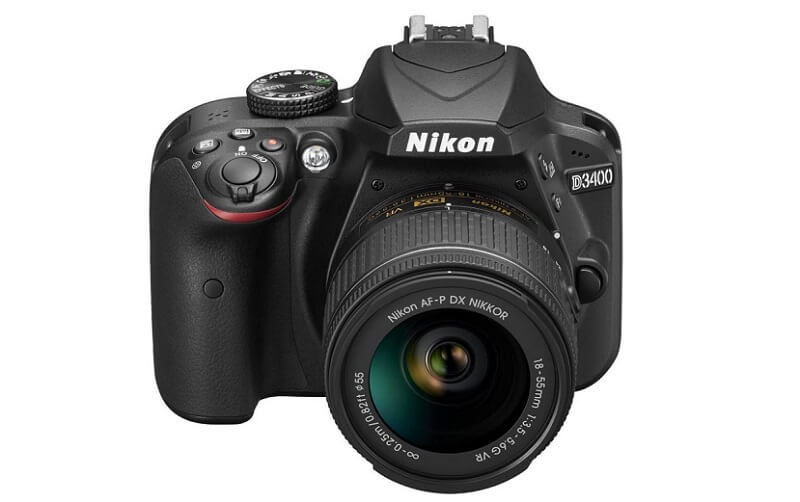What lens to get for your Nikon D3400?
Released in January 2017, the Nikon D3400 is a consumer-oriented SLR camera designed for those who would like to take pictures with a first camera that is easy to use. It is an update of the Nikon D3300, which includes the main technical features: a 24MP APS-C CMOS sensor, an EXPEED 4 processor, an autofocus on 11 collimators, a sensitivity of up to ISO 25600, a 3-inch 921,000 dot non- touch screen, an integrated flash, and a 1080p video mode that increases to 60 frames per second. The design is in every way the same as its predecessor, with a small housing that uses the same location of the keys.
For new features, the Nikon D3400 only provides Snapbridge connectivity via Bluetooth, which allows you to automatically transfer your images to a smartphone. A microphone plug that was present on the D3300 is missing…. However, its autonomy has been greatly improved compared to the previous model. Despite the lack of innovation, it remains a versatile and accessible camera that will appeal to novice photographers.
- Snap Bridge Bluetooth Connectivity
- 24.2MP DX-Format CMOS Sensor
- Up to 95MB/s & 20MB/s read & write speeds respectively; Class 10 UHS 1
Sold as a kit with the classic 18-55mm or 18-105mm, the Nikon D3400 can only really show you what it has in store if you use a lens that offers superb image quality.
If you are looking for a lighter lens, with a better zoom, that offers better sharpness or a beautiful background blur, this selection of the best lenses compatible with the Nikon D3400 can help you choose the right tool for your style of photography.
Please leave a comment if you have any suggestions or ideas to improve this list!
Note: Product links in this article lead to Amazon.com
Acronyms and abbreviations to know:
DX: This term means that the lens is specially designed for APS-C sensor cameras such as the Nikon D3400. DX lenses are generally more compact, lighter and less expensive.
FX: This term refers to lenses compatible with 24x36mm full-format sensor cameras (larger than APS-Cs). In concrete terms, if the lens is not labelled FX or DX, it means that it is optimized for full-format cameras.
Note: FX lenses are compatible with APS-C sensor housings, but a multiplier of 1.5 will be required to determine the equivalent focal length. For example, the Nikon AF-S 50 mm f/1.8G mentioned in this article actually gives a focal length of 75mm when mounted on a Nikon D3400.
AF-S (AutoFocus SWM): means that the lens is equipped with an autoFocus (an autofocus) with SWM motor (for “Silent Wave Motor”). This motorization allows a fast, precise and almost silent focusing. Most Nikon lenses use this technology and therefore the AF-S name is very often found in their names.
AF-P (AutoFocus Pulse): This is a new motorization launched at the beginning of 2016: technically it’s a stepping motor that is particularly suitable for video: the focus is fluid, smooth and practically without mechanical noise.
G: Type G lenses do not have an aperture adjustment ring. The selection of the aperture can therefore only be made from the camera via the camera’s dial. This is the case for most recent lenses.
DC: Sigma DC lenses are optimized for APS-C sensor SLR cameras and are not compatible with full-format SLR cameras.
ED: means that the lens has a lens with a low light dispersion glass type, which corrects chromatic aberrations (defects in the image) and provides better contrast and superior color correction.
VR (Vibration Reduction): means that the lens incorporates an optical image stabilizer that helps reduce vibration, and prevents motion blur when using the hand-held camera.
Summary
- Nikon AF-S DX 35 mm f/1.8G
- Nikon AF-S 50 mm f/1.8G
- Sigma 17-50 mm F2,8 DC EX OS HSM
- Sigma 10-20 mm F3.5 EX DC HSM
- Nikon AF-S DX 55-300 mm f/4,5-5,6 ED VR série G
- Comparative Table
- Useful accessories
- Links
Nikon AF-S DX 35 mm f/1.8G
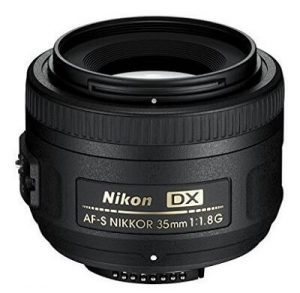
Filter size: 52 mm
If you were to buy only one lens for your Nikon D3400, it would be this one! It is a fixed focal length (you cannot zoom in/out) so you will have to move to get the desired framing. But unlike a zoom lens like the 18-55mm, this lens offers extremely sharp pictures, and its f/1.8 aperture provides a beautiful bokeh (or background blur)!
Its f/1.8 aperture also allows you to shoot even in low-light conditions (no more flash). Its autofocus is silent and fast, it’s compact and discreet, and its price is very attractive. The only disadvantage is that it does not have an integrated image stabilizer, which can be annoying if you make video by hand.
To put it simply, this is the lens that every D3400 owner should have to replace the 18-55mm.
_
Nikon AF-S 50 mm f/1.8G
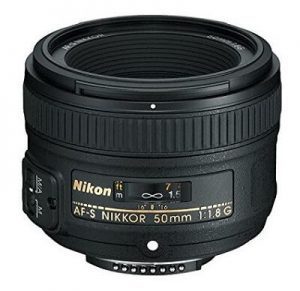
Filter size: 58 mm
Technically, this is a lens dedicated to the FX full-format camera, but it’s compatible with APS-C sensor cameras and gives the focal length equivalent of 75mm. I reassure you, we lose absolutely nothing in quality! It’s one of the best lenses of this selection in terms of image quality, but also one of the lightest and cheapest.
Its focal length is more suitable for taking portraits, with a very nice bokeh (background blur) that will give a professional look to your photos. It’s very suitable in situations where the light is low (wedding, concert…).
If you are a beginner with your SLR and want to improve or simply want to get the most out of your Nikon D3400, you will be amazed by the photo rendering of this 50mm f/1.8.
_
Sigma 17-50 mm f/2.8 DC EX OS HSM
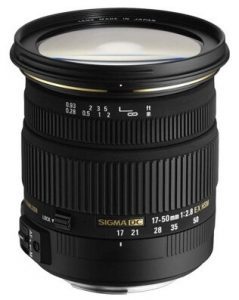
Filter size: 77 mm
So you don’t want to bother with several lenses? This 17-50mm from Sigma is the lens you need. It allows to make more beautiful images than the 18-55mm sold in kit, and even if it zooms a little less its focal range allows to make landscape photos as well as portraits and it’s therefore very versatile when travelling.
It has a fixed aperture of f/2.8 over the entire focal range, which allows beautiful images to be obtained even in low-light conditions and a beautiful depth of field. For the weak points, we can mention its weight of 570g, but it’s the sacrifice to make to benefit from a zoom with a constant aperture.
Be careful, when you buy the Sigma 17-50mm on Amazon.fr select the Nikon mount (Amazon offers the choice between Sony mount, Canon…).
_
Sigma 10-20 mm f/3.5 EX DC HSM
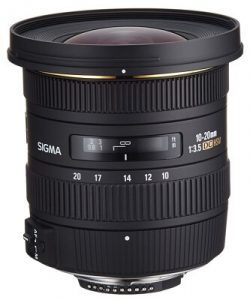
Filter size: 82 mm
This is the lens to get if you want to make landscape, architectural or interior photography. Its design is compact, its finish is good, its autofocus is fast and it’s able to make very sharp images, even if there is a little distortion visible at 10mm. Its constant aperture of f/3.5 also allows you to take pictures where the brightness is not very good or in museums where flashes are prohibited.
Although it’s the most expensive lens in this selection, it offers good performance and is one of the cheapest wide angles for Nikon APS-C cameras. It’s also supplied with a protective pouch and a lens hood.
If you want to take spectacular travel photos, this is the right lens to have.
_
Nikon AF-S DX 55-300 mm f/4.5-5.6 ED VR série G
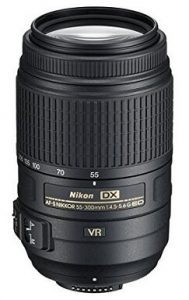
Filter size: 58 mm
A good additional lens to complete the 18-55mm. Very practical, it allows you to zoom up to 300mm to get closer to the subject of the photo but it’s also very useful for portrait photography. Stabilized and silent, it will be perfect for beginners who want to take up animal or sports photography.
Beware of Tamron and Sigma zoom lenses sold at lower prices but which do not benefit from a vibration reduction system! This is a crucial point to take into account if you want to avoid missing every other photo, so it’s better to choose Nikon if you want to avoid disappointments!
If you find the weight of this 55-300mm too heavy and a shorter focal length does not bother you, Nikon also offers a 55-200mm, at a price almost half as expensive.
_
COMPARATIVE TABLE
All of the Nikon D3400 compatible lenses mentioned above are included in this comparison chart to help you choose the right equipment. You will be able to compare them according to their price, the weight and the utility of each one to choose which will suit your budget and your style of photo.
| Lens | Price | Weight | Aperture | Utility |
|---|---|---|---|---|
| Nikon 35 mm f/1.8G AF-S DX | $$$$$ | 200 g | f/1.8 | landscape / street photography |
| Nikon 50 mm f/1.8G AF-S | $$$$$ | 187 g | f/1.8 | portrait |
| Sigma 17-50 mm f/2.8 DC EX OS HSM | $$$$$ | 465 g | f/2.8-4 | all-in-one |
| Sigma 10-20 mm f/3.5 EX DC HSM | $$$$$ | 520 g | f/3.5 | wide angle (architecture, landscape) |
| Nikon 55-300 mm f/4,5-5,6 AF-S DX ED VR G | $$$$$ | 335 g | f/4-5.6 | zoom |
_
USEFUL ACCESSORIES
A small selection of useful accessories to have in addition to your lenses and your Nikon D3400:
- Cleaning accessories
- Fast SD card
- Buy the Nikon D3400 now!
- Snap Bridge Bluetooth Connectivity
- 24.2MP DX-Format CMOS Sensor
- Up to 95MB/s & 20MB/s read & write speeds respectively; Class 10 UHS 1
LINKS
- All the Nikon DX lenses on the Nikon USA website.
